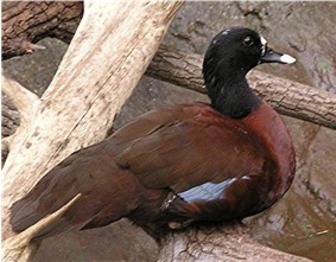Hartlaub's Duck
Analysis of mtDNA sequences of the cytochrome b and NADH dehydrogenase subunit 2 genes suggests that it belongs into a very distinct clade—possibly a subfamily of its own—together with the Blue-winged Goose, another African species of waterfowl with uncertain affinities.

Original source: Hartlaub's eend Pteronetta hartlaubii eigen foto
Permission: GNU Free Documentation License
The Hartlaub's Duck is classified as Least Concern. Does not qualify for a more at risk category. Widespread and abundant taxa are included in this category.
The Hartlaub's Duck (Pteronetta hartlaubii) is a dark chestnut-coloured duck of African forests. Formerly included in the paraphyletic "perching duck" assemblage, it was later moved to the dabbling duck assemblage. However, it is fairly distinct from the "typical" dabbling ducks, and is placed in the monotypic genus Pteronetta to reflect this. More
The Hartlaub's Duck (Pteronetta hartlaubii) is found along the shaded rain forest streams, and ponds of western Africa. They are said to perch in trees over water. Where suitable wetland habitat is present the birds are around, the plight of this species however, will follow that of the countless other creatures and plants that exist in our shrinking rainforests. There has been some success however in breeding numerous waterfowl species in captivity. More
Hartlaub's Duck is resident in equatorial West and Central Africa, from Guinea and Sierra Leone east through Nigeria to Sudan, and south to Gabon, Congo and Zaire. Citations 1. BirdLife International (2005). Pteronetta hartlaubii. 2006. IUCN Red List of Threatened Species. IUCN 2006. www.iucnredlist.org. Retrieved on 11 May 2006. 2. Madge & Burn 1987, p. More
Hartlaub's Duck Pteronetta hartlaubii Black Bee-eater Merops gularis Denham's Bustard Neotis denhami 1c 75 Guinea Turaco Tauraco persa 2c 212 Olive-bellied Sunbird Cinnyris chloropygius 3c 156 Western Oriole Oriolus brachyrhynchus 5c More
Hartlaub's Duck: is it really Near Threatened? 2004 - From the Globally Threatened Bird Forums @ BirdLife.org The Hartlaub's Duck is currently considered Near Threatened (almost meeting criteria A2c,d; A3c,d), because population declines are believed to approach 30% in ten years/three generations. Hunting, increasing slash-and-burn cultivation, water pollution from mining and poison-fishing, and hydrological changes owing to logging may all possibly be threats. More

Original source: MGA73bot2
Author: MGA73bot2
Permission: Some rights reserved
Family : Anatidae
Genus : Pteronetta
Species : hartlaubii
Authority : (Cassin, 1859)

